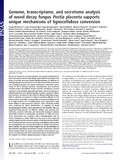Mostrar el registro sencillo del ítem
Genome, transcriptome, and secretome analysis of wood decay fungus Postia placenta supports unique mechanisms of lignocellulose conversion
| dc.creator | Martínez, Diego | es_ES |
| dc.creator | Challacombe, Jean | es_ES |
| dc.creator | Morgenstern, Ingo | es_ES |
| dc.creator | Hibbett, David | es_ES |
| dc.creator | Schmoll, Monika | es_ES |
| dc.creator | Kubicek, Christian P. | es_ES |
| dc.creator | Ferreira, Patricia | es_ES |
| dc.creator | Pisabarro de Lucas, Gerardo | es_ES |
| dc.creator | Lavín Trueba, José Luis | es_ES |
| dc.creator | Oguiza Tomé, José Antonio | es_ES |
| dc.date.accessioned | 2018-12-28T09:14:03Z | |
| dc.date.available | 2018-12-28T09:14:03Z | |
| dc.date.issued | 2009 | |
| dc.identifier.issn | 0027-8424 (Print) | |
| dc.identifier.issn | 1091-6490 (Electronic) | |
| dc.identifier.uri | https://hdl.handle.net/2454/31882 | |
| dc.description.abstract | Brown-rot fungi such as Postia placenta are common inhabitants of forest ecosystems and are also largely responsible for the destructive decay of wooden structures. Rapid depolymerization of cellulose is a distinguishing feature of brown-rot, but the biochemical mechanisms and underlying genetics are poorly understood. Systematic examination of the P. placenta genome, transcriptome, and secretome revealed unique extracellular enzyme systems, including an unusual repertoire of extracellular glycoside hydrolases. Genes encoding exocellobiohydrolases and cellulose-binding domains, typical of cellulolytic microbes, are absent in this efficient cellulose-degrading fungus. When P. placenta was grown in medium containing cellulose as sole carbon source, transcripts corresponding to many hemicellulases and to a single putative β -1–4 endoglucanase were expressed at high levels relative to glucose-grown cultures. These transcript profiles were confirmed by direct identification of peptides by liquid chromatography-tandem mass spectrometry (LC-MS/MS). Also upregulated during growth on cellulose medium were putative iron reductases, quinone reductase, and structurally divergent oxidases potentially involved in extracellular generation of Fe(II) and H2O2. These observations are consistent with a biodegradative role for Fenton chemistry in which Fe(II) and H2O2 react to form hydroxyl radicals, highly reactive oxidants capable of depolymerizing cellulose. The P. placenta genome resources provide unparalleled opportunities for investigating such unusual mechanisms of cellulose conversion. More broadly, the genome offers insight into the diversification of lignocellulose degrading mechanisms in fungi. Comparisons with the closely related white-rot fungus Phanerochaete chrysosporium support an evolutionary shift from white-rot to brown-rot during which the capacity for efficient depolymerization of lignin was lost. | en |
| dc.description.sponsorship | This work was supported by the U.S. Department of Energy’s Office of Science, Biological and Environmental Research Program, and University of California, Lawrence Berkeley National Laboratory Contract DE-AC02–05CH11231; Lawrence Livermore National Laboratory Contract DE-AC52–07NA27344; Los Alamos National Laboratory Contract DE-AC02–06NA25396; University of Wisconsin Grant DE-FG02–87ER13712; Forest Products Laboratory, U.S. Department of Agriculture, Cooperative State Research, Education, and Extension Services Grant 2007–35504-18257; National Institutes of Health Grant GM060201 (to University of New Mexico); Centro de Investigaciones Biológicas (Madrid) EUproject NMP2–2006-026456; Ministry of Education Czech Republic Grant LC06066. | en |
| dc.format.extent | 6 p. | |
| dc.format.mimetype | application/pdf | en |
| dc.format.mimetype | application/zip | en |
| dc.language.iso | eng | en |
| dc.publisher | National Academy of Sciences | en |
| dc.relation.ispartof | PNAS, February 10, 2009 106 (6) 1954-1959 | en |
| dc.rights | © 2009 by The National Academy of Sciences of the USA | en |
| dc.subject | Postia placenta | en |
| dc.subject | Cellulose | en |
| dc.subject | Fenton | en |
| dc.subject | Lignin | en |
| dc.subject | Cellulase | en |
| dc.subject | Brown-rot | en |
| dc.title | Genome, transcriptome, and secretome analysis of wood decay fungus Postia placenta supports unique mechanisms of lignocellulose conversion | en |
| dc.type | info:eu-repo/semantics/article | en |
| dc.type | Artículo / Artikulua | es |
| dc.contributor.department | Producción Agraria | es_ES |
| dc.contributor.department | Nekazaritza Ekoizpena | eu |
| dc.rights.accessRights | info:eu-repo/semantics/openAccess | en |
| dc.rights.accessRights | Acceso abierto / Sarbide irekia | es |
| dc.identifier.doi | 10.1073/pnas.0809575106 | |
| dc.relation.publisherversion | https://doi.org/10.1073/pnas.0809575106 | |
| dc.type.version | info:eu-repo/semantics/publishedVersion | en |
| dc.type.version | Versión publicada / Argitaratu den bertsioa | es |


